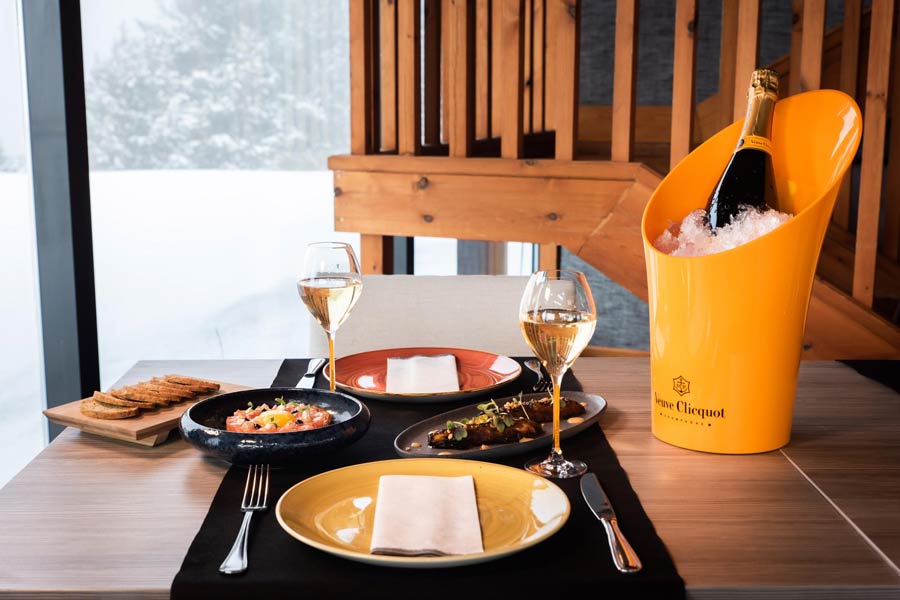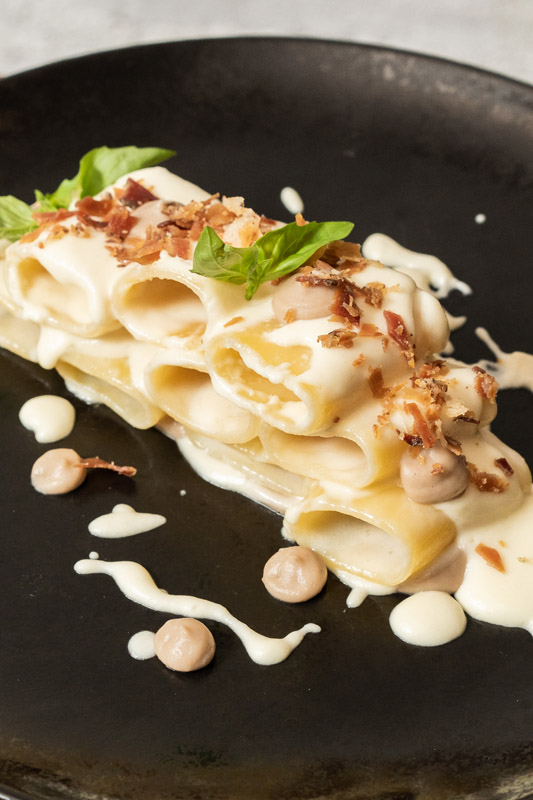Welcome to my weekly dig through the pile of wine samples that show up asking to be tasted. I’m pleased to bring you the latest installment of Vinography Unboxed, where I highlight some of the better bottles that have crossed my doorstep recently.
This week included a couple of really pleasurable white wines. The first was a Picpoul Blanc (an unusual grape variety to find anywhere outside its home in southern France) from Two Shepherds winery. It’s crisp and juicy but with a richness of flavor that makes it a bit more serious than you expect it to be when you first put it in your mouth.
The second is a really lovely Chardonnay from the Finger Lakes region of New York, by long-standing producer Ravines. It’s lean and bright and wonderfully elegant, and a steal at only $20.
Two Shepherds also offered up two red wines this week, their Mendocino Carignan, which is made in a crunchy, low-alcohol style and has all the berry and sour goodness you expect from the grape. The other wine is their Pastoral Melange, a really tasty blend of their Carignan and Cinsault. I’m finishing off a glass of this wine (with a bit of chill on it) as I write this, and it’s just an eminently drinkable wine.
I’ve also got a Russian River Pinot Noir from Raeburn cellars this week, which is a classic expression of why Russian River Pinot has been charming wine lovers for decades.
Also mixed in there this week I’ve got a very classic expression of Rioja, courtesy of CVNE, one of the region’s largest and most historical producers, founded in 1879 and family-run for more than 5 generations. Their wines are, as is typical for the region, aged in American oak, giving the wine a very particular flavor profile that some love and some don’t. Personally, I don’t love it, but that can’t stop me from admiring a well-made wine..
We can finish out the week with a bunch of “serious” Cabernet Sauvignons, starting with the third single-parcel effort from Knights Bridge Winery (I reviewed two others recently). Like its siblings, it’s a pretty well-made expression of the form and an excellent standard-bearer for the quality of Sonoma County Cabernet Sauvignon.
I got my first taste of Boich Family Wines this week with their top-of-the-line Beckstoffer To-Kalon Cabernet Sauvignon, which is reasonably well made, but not nearly as impressive as it should be given the price tag.
Finally, I was sent the three most recent vintages of Charles Krug Winery’s flagship Vintage Selection Cabernet Sauvignon. This is a historic bottling from a historic winery in Napa, and represents their dedication to the Mondavi family heritage that revitalized the winery in the late 1940s. Starting from their very first harvest at the winery in 1944 (the winery itself was originally founded in 1861), the family decided to make a separate bottling of some of its best grapes under the Vintage Selection name (it was actually called Select Cabernet for its first couple of years) and has continued the tradition ever since. These are wines built for long aging, and manage to be pretty balanced despite somewhat elevated alcohol levels.
Tasting Notes

2019 Two Shepherds “Windmill Vineyards” Picpoul Blanc, Yolo County, California
A light yellow-gold in color, this wine smells of lemon curd and a touch of seawater. In the mouth, bright lemony and grapefruit citrus flavors are sharp and juicy thanks to excellent acidity. There’s also a hint of candle wax to the flavor and a faintly honeyed richness that is perceived aromatically rather than as any weight on the palate. Nice wet-pavement minerality. Aged for 8 months in 50% stainless steel, and 50% neutral oak puncheons. 12.1% alcohol. 250 cases made. Score: between 8.5 and 9. Cost: $20. click to buy.
2017 Ravines Chardonnay, Finger Lakes, New York
Pale greenish-gold in color, this wine smells of lemon curd and buttered popcorn. In the mouth, crackling lemon curd and white floral notes have a lovely zing thanks to excellent acidity. There’s a faint hint of melted butter but this is mostly a citrusy dance party on the palate. Quite delicious. 12.5% alcohol. Score: around 9. Cost: $20. click to buy.
2018 Two Shepherds “Trimble Vineyard” Carignan, Mendocino County, California
A bright medium purple in the glass, this wine smells of blackberries and black cherry. In the mouth, juicy, slightly sour black cherry flavors are dusted with powdery tannins that buff the edges of the palate and grow a little more muscular as the tangy red and black fruit lingers with a SweetTart sourness in the finish. Excellent acidity. Made from 45-year-old, organically dry-farmed, head-trained vines. Fermented in neutral oak barrels. 12.18% alcohol. 525 cases made. Score: around 8.5. Cost: $26. click to buy.
2019 Two Shepherds “Pastoral Melange” Red Blend, California
Light to medium garnet in the glass, this wine smells of boysenberries and strawberry jam. In the mouth, juicy bright boysenberry and strawberry flavors have a kick, thanks to excellent acidity, which leaves a SweetTart sourness in the finish that is positively mouthwatering. Hints of herbs add complexity, but this definitely hits the “glou glou” bullseye. A blend of stainless-steel fermented and aged Cinsault and carbonically macerated Carignan fermented in neutral barrels. 11.4% alcohol. 50 cases made. Score: around 9. Cost: $26. click to buy.
2019 Raeburn Pinot Noir, Russian River Valley, Sonoma, California
Light to medium garnet in color, this wine smells of raspberry and cranberry fruit. In the mouth, bright cranberry and cedar flavors mix with chopped herbs and a touch of sawdust. Excellent acidity keeps things juicy and leaves a citrus-peel brightness in the finish. Faint tannins dust the edges of the mouth. 14.5% alcohol. Score: between 8.5 and 9. Cost: $23. click to buy.
2015 CVNE “Imperial Reserva” Rioja, Spain
Medium to dark garnet in color, this wine smells of black cherry, leather, and whiskey barrels. In the mouth, juicy black cherry and boysenberry flavors are shot through with the strong coconut sunscreen, bourbon barrel flavors of American oak. Smooth, fine-grained tannins are stretched taut in the mouth, as the wine courses, silky across the palate. Refined and tasty, just too much wood for my taste. Usuall contains a bit of Graciano and Mazuelo, in addition to its primary grape, Tempranillo. 14.5% alcohol. Score: around 8.5. Cost: $28. click to buy.
2017 Knights Bridge “Haggerty” Cabernet Sauvignon, Knights Valley, Sonoma, California
Very dark garnet in color, this wine smells of black cherry and a touch of woodsmoke. In the mouth, rich black cherry, sweet pipe tobacco and cocoa powder flavors are wrapped in a fleecy blanket of tannins. Black cherry and black currant notes linger in the finish with a hint of sagebrush. This wine represents a single-block from the estate vineyard planted with the See clone of Cabernet. 14.5% alcohol. Score: around 9. Cost: $150. click to buy.
2017 Boich Family Cellar “Beckstoffer To Kalon Vineyard” Cabernet Sauvignon, Napa Valley, California
Very dark garnet in the glass, this wine smells of black cherry and licorice. In the mouth, rich, and slightly sweet black cherry fruit mixes with black currant and cola under a gauzy throw of tannins. Slightly high-toned (a bit too much for my taste), this wine seems to float above the palate a bit, lingering with a somewhat ethereal finish of black currants. 15.5% alcohol. Score: around 8.5. Cost: $300. click to buy.

2014 Charles Krug “Vintage Selection” Cabernet Sauvignon, Napa Valley, Napa, California
Very dark garnet in color, this wine smells of black cherry and cola. In the mouth, gorgeously bright, juicy black cherry fruit is melded to a cola and mocha core to the wine. Suede-like tannins wrap around the core of fruit. Contains 2% Petit Verdot. There’s a touch of heat in the finish that betrays the wine’s 15.5% alcohol level. Score: between 9 and 9.5. Cost: $125. click to buy.
2015 Charles Krug “Vintage Selection” Cabernet Sauvignon, Napa Valley, California
Very dark garnet in the glass, this wine smells of cassis and black cherry. In the mouth, rich black cherry and cassis flavors mix with licorice and blueberries. Suede-like tannins wrap around the core of fruit. Reads as high octane, with some burn in the finish. Tannins flex their muscles for a while in the mouth. Contains 4% Petit Verdot. 15.8% alcohol. Score: around 9. Cost: $125. click to buy.
2016 Charles Krug “Vintage Selection” Cabernet Sauvignon, Napa Valley, California
Very dark garnet in the glass, this wine smells of black cherry and blackberry with a hint of tobacco. In the mouth, rich black cherry and blackberry are wrapped in a taut muscular fist of tannins. Excellent acidity keeps this wine fairly fresh feeling in the mouth, with the black cherry and cola notes touched by a green herbal quality. Notes of mocha linger in the finish. Nicely balanced. A third of this fruit comes from the winery’s Howell Mountain property. The balance of fruit comes from two vineyards just south of Yountville. 15.4% alcohol. Score: between 9 and 9.5. Cost: $125. click to buy.
The post Vinography Unboxed: Week of 2/21/20 appeared first on Vinography.
* This article was originally published here



